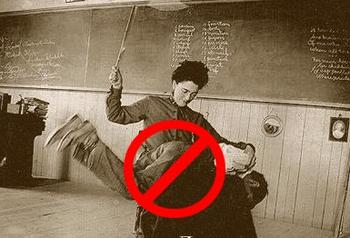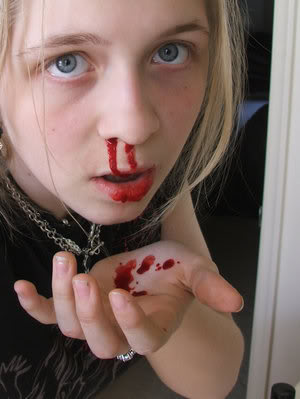(Note: Part 1 is here… http://clickandtreat.com/wordpress/?p=388)
To refresh your memory about the topic, I have presented a case for the idea that punishment is innate in humans and a key survival behavior of both individuals and groups. For millions of years this fact has not been questioned.
Today, legions of people wish to suggest that punishment is universally bad. They do what I have not – they strip their arguments of any context. For instance, in the coercion free society, punishing a child for beating up other children is bad. It might hurt the child’s self esteem. It might cause “acting out” or rebellious behavior. What if the child on the left is responsible for the bloody nose on the right? In the context-free world, that the child is puni shing other children and collecting allies to punish even more children is ignored. Why is no concern given to the child who comes home with a bloody nose from the fist of the bully? This reasoning side-steps the fact that punishment is intended to stop unacceptable behavior and works beautifully when used for that purpose. Meaning pun
shing other children and collecting allies to punish even more children is ignored. Why is no concern given to the child who comes home with a bloody nose from the fist of the bully? This reasoning side-steps the fact that punishment is intended to stop unacceptable behavior and works beautifully when used for that purpose. Meaning pun ishing the bully stops the bullying and “sends a message” to others who would use force to dominate the weak and powerless. In essence, failing to punish the bully hurts the innocent victims of the bullying. The same is true of animals, for the same reason. The goal of using punishment is to both stop the behavior immediately and to leave an inhibition to a recurrence of the behavior. The question shouldn’t be whether we should punish, but how best to do it. That also is never examined in the anti-punishment catechism. Which leads to our next question – can punishment actually stop aggression. Ideologues say no.
ishing the bully stops the bullying and “sends a message” to others who would use force to dominate the weak and powerless. In essence, failing to punish the bully hurts the innocent victims of the bullying. The same is true of animals, for the same reason. The goal of using punishment is to both stop the behavior immediately and to leave an inhibition to a recurrence of the behavior. The question shouldn’t be whether we should punish, but how best to do it. That also is never examined in the anti-punishment catechism. Which leads to our next question – can punishment actually stop aggression. Ideologues say no.
Factors:
Only an idiot or an ideologue would claim that punishment doesn’t work to stop behavior. That’s what B.F. Skinner implied in his book, Science and Human Behavior.
“More recently, the suspicion has also arisen that punishment does not in fact do what it is supposed to do. An immediately effect in reducing a tendency to behave is clear enough, but this may be misleading. The reduction in strength may not be permanent.”
That is plainly contradicted by casual observation of behavior in context. I don’t intentionally touch hot stoves – ever. I learned that very early. I have had my inhibition updated periodically by accidentally touching hot things. The initial punishment has helped me generalize the inhibition so that even warm objects will make me cautious about touching them. So what if it took more than one repetition? The reapplication of the punishment simply makes me safer and punishes a lack of caution. That’s a good thing. Life punishes harmful behavior. I’m cool with that. However, wise humans punish anti-social or dangerous behavior before it kills someone or disrupts the civil society. This hasn’t changed since we lived in small tribes. Eat the seed corn and you will be punished. Molest a child and you will be punished. The injunctions in the Ten Commandments are there for a reason. They make society safer by teaching all members inhibitions that lead to a civil society. That it’s not perfect is an obvious fact. Only ideologues demand utopia. Additionally, a society without punishment is anarchy – which means no restraint. Kinda like pirates.
The admission that punishment is a beneficial aspect of human behavior leads to the most important reason to use punishment. Prophylaxis.
Prophylaxis and Behavior:
pro·phy·lax·is
noun: prophylaxis
- action taken to prevent disease, especially by specified means or against a specified disease.
“the treatment and prophylaxis of angina pectoris”
| synonyms: | preventive treatment, prevention, protection, precaution |
To start, using a medical term to describe behavior isn’t a stretch, it’s an analog. Behavior is a bodily function no different than secreting hormones. The brain is an organ just like your heart and liver. As you can see, propylaxis describes something that is done to prevent a disease. For instance, all vaccinations are forms of prophylactic medicine. To use the term in the context of behavior is an analog.
And now I digress. Last September I gave two presentations on the East Coast. I had to vaccinate my cats so they could be boarded. Vets are smart. They use allite ration and give leukemia vaccinations in the left hind leg and rabies vaccinations in the right. (L vs R) So, my 11 year old beloved cat, Pouncer, developed a fibrous sarcoma in his right hind leg because of a vaccination he didn’t need. He is an exclusively house-bound cat and always will be. We had the tumor removed. It came back, fast. We have had more tissue removed in hopes that he will survive. Probably not. It’s an aggressive cancer – as the result of a prophylactic procedure gone wrong. Life is what it is. There is no guarantee. We do our best and bite the bullet when it goes wrong. Now, back to the story.
ration and give leukemia vaccinations in the left hind leg and rabies vaccinations in the right. (L vs R) So, my 11 year old beloved cat, Pouncer, developed a fibrous sarcoma in his right hind leg because of a vaccination he didn’t need. He is an exclusively house-bound cat and always will be. We had the tumor removed. It came back, fast. We have had more tissue removed in hopes that he will survive. Probably not. It’s an aggressive cancer – as the result of a prophylactic procedure gone wrong. Life is what it is. There is no guarantee. We do our best and bite the bullet when it goes wrong. Now, back to the story.
For instance, if I punish a dog for ‘puppy biting’, I can prevent the dog from “adult biting.” That is a true statement of my many years experience with thousands of dogs. It is also a true fact that it is easier to punish a puppy for such a behavior than it is to punish an adult after a serious bite. A smart person would then include ‘punishment for biting’ with the training of all puppies. That is because we apply the preventive treatment to avoid a more serious condition. Punishing “puppy biting” reduces the ten million or so “adult bites” in the US every year. This is mirrored by vaccinations against parvo virus that saves countless lives but requires jabbing a steel needle into a helpless puppy. How cruel.
In the case of prophylactic punishment, the punishment is applied before the behavior becomes serious. This causes the brains of anti-punishment ideologues to explode. “But he was only playing! You can’t punish a puppy for playing!!” Why not? That is the perfect time. Puppies play-bite to learn how to become expert adult biters. It’s a biological imperative. A wolf that cannot slash and tear cannot hunt or defend itself. Again, the biological perspective confirms what we all know.
Play is practice. Practice makes habit. Practice with aversive consequences for failure makes perfect. To see the objection in a bigger context, punishing a dog for putting its teeth on humans does not influence any other form of acceptable play. The pup will not be “play deprived.” Seriously, why would stopping all biting be harmful to a dog? Allowing biting sets the animal up to do a behavior that is most often fatal. Is that possibility so unimportant that a responsible owner or trainer doesn’t consider it? This anti-logical reasoning is dependent on both removing context and creating an “imagined harm.” http://clickandtreat.com/wordpress/?p=270 To oppose punishment as a prophylaxis is to assume that having to stop an adult, skilled biter is somehow better than stopping the behavior before it gets out of hand. One problem. If the dog is an adult biter, somebody got bit. With a prophylactic punishment no one gets hurt – just like the parvo vaccination.
To read the series, use these links
Part 1
Part 2
Part 3
Part 4
Part 5
Part 6


Hello Gary, I had been waiting for part 2, didn’t realize until today it was posted.
I had a teacher once who talked about practice. The adage practice make perfect is not exactly right unless you are practicing it perfectly. Practice makes permanent was what he always said. If you practice it wrong you will do it wrong. Your changing behavior in puppies makes great sense, before they practice a bad behavior and it becomes permanent.
I wish I could get to one of you seminars but I live in the Midwest. Maybe someday you can schedule one closer. keep up the good work.